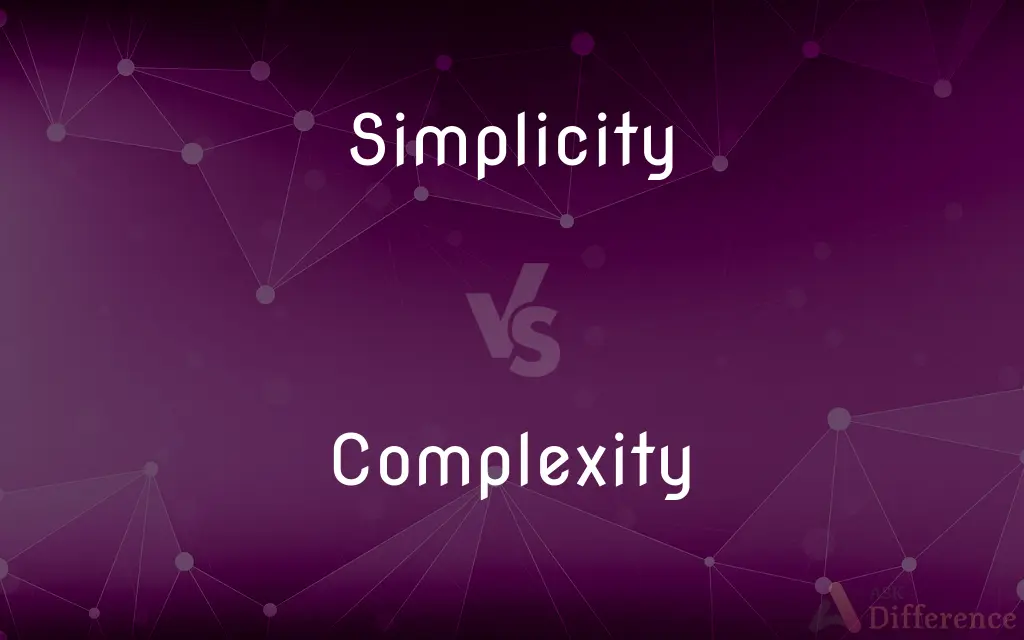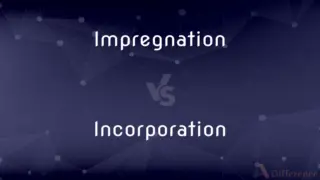Simplicity vs. Complexity — What's the Difference?
By Tayyaba Rehman & Urooj Arif — Updated on March 16, 2024
Simplicity implies ease and clarity, focusing on the essence, while complexity involves multiple interconnected parts, often leading to challenges in understanding or execution.

Difference Between Simplicity and Complexity
Table of Contents
ADVERTISEMENT
Key Differences
Simplicity is characterized by ease, clarity, and minimalism, often aiming to strip ideas, designs, or processes down to their fundamental aspects. It values efficiency and accessibility, making concepts, products, or systems easier to understand and use. Complexity, on the other hand, denotes a high level of intricacy and interconnectedness, with multiple components and variables interacting in ways that can be challenging to grasp and manage.
In design, simplicity seeks to create user-friendly, intuitive interfaces and products, emphasizing the 'less is more' philosophy. Complex designs, while potentially offering more features or functionalities, may overwhelm users with choices and reduce overall usability and effectiveness.
Simplicity in communication involves conveying messages in a clear, straightforward manner, making information accessible to a broad audience. Complex communication, with its nuanced and detailed nature, may provide deeper insights but can also lead to misunderstandings if not properly decoded.
The pursuit of simplicity often involves distilling concepts or processes to their core, removing unnecessary elements to enhance focus and effectiveness. Complexity accepts and even embraces the multiplicity of elements and their interactions, recognizing that certain situations or problems require nuanced approaches.
While simplicity and complexity might seem diametrically opposed, they can coexist and complement each other. For instance, a complex system might employ a simple interface to improve user interaction, or a simple concept might lead to complex and rich outcomes when applied creatively.
ADVERTISEMENT
Comparison Chart
Nature
Minimal and clear
Intricate and interconnected
Design
User-friendly, intuitive
Feature-rich, detailed
Communication
Straightforward, accessible
Nuanced, detailed
Approach
Distillation to essentials
Embrace of multiplicity
Outcome
Ease of use, efficiency
Richness, depth
Compare with Definitions
Simplicity
Focuses on the essentials for clarity and efficiency.
A simple website design improves user navigation.
Complexity
Involves multiple, often interdependent, components.
A complex machine requires understanding of all its parts for repair.
Simplicity
Conveys messages in an unambiguous way.
Simple language in public notices ensures widespread understanding.
Complexity
Provides in-depth, comprehensive information.
Complex academic texts offer thorough exploration of topics.
Simplicity
Makes concepts or instructions accessible.
Simple instructions ensure broader comprehension.
Complexity
Requires deeper insight for full appreciation.
Understanding complex social issues demands awareness of various factors.
Simplicity
Prioritizes ease of use in product design.
A simple appliance interface enhances usability.
Complexity
Employs intricate structures for specific goals.
Complex security systems provide robust protection through multiple layers.
Simplicity
Streamlines processes to eliminate redundancy.
A simple workflow increases productivity and reduces errors.
Complexity
Offers a wide range of functionalities.
A complex software suite caters to diverse user needs.
Simplicity
Simplicity is the state or quality of being simple. Something easy to understand or explain seems simple, in contrast to something complicated.
Complexity
Complexity characterises the behaviour of a system or model whose components interact in multiple ways and follow local rules, meaning there is no reasonable higher instruction to define the various possible interactions.The term is generally used to characterize something with many parts where those parts interact with each other in multiple ways, culminating in a higher order of emergence greater than the sum of its parts. The study of these complex linkages at various scales is the main goal of complex systems theory.
Simplicity
The quality or condition of being easy to understand or do
For the sake of simplicity, this chapter will concentrate upon one theory
Complexity
The quality or condition of being complex.
Simplicity
The quality or condition of being plain or uncomplicated in form or design
The grandeur and simplicity of Roman architecture
Complexity
One of the components of something complex
A maze of bureaucratic and legalistic complexities.
Simplicity
The property, condition, or quality of being simple or uncombined.
Complexity
(uncountable) The state of being complex; intricacy; entanglement.
Simplicity
Absence of luxury or showiness; plainness.
Complexity
(countable) That which is and renders complex; intricacy; complication.
Simplicity
Absence of affectation or pretense.
Complexity
The state of being complex; intricacy; entanglement.
The objects of society are of the greatest possible complexity.
Simplicity
Lack of sophistication or subtlety; naiveté.
Complexity
That which is complex; intricacy; complication.
Many-corridored complexitiesOf Arthur's palace.
Simplicity
Lack of good sense or intelligence; foolishness.
Complexity
The quality of being intricate and compounded;
He enjoyed the complexity of modern computers
Simplicity
Clarity of expression.
Simplicity
Austerity in embellishment.
Simplicity
The state or quality of being simple
Simplicity
The quality or state of being unmixed or uncompounded
The simplicity of metals or of earths
Simplicity
The quality or state of being not complex, or of consisting of few parts
The simplicity of a machine
Simplicity
Lack of sharpness of mind; lack of ability to think using complex ideas; stupidity
Simplicity
Lack of artificial ornament, pretentious style, or luxury; plainness
Simplicity of dress, of style, or of language
Simplicity of diet
Simplicity of life
Simplicity
Lack of subtlety or abstruseness; clarity
The simplicity of a doctrine
The simplicity of an explanation or a demonstration
Simplicity
Lack of complication; efficiency.
Simplicity
An act or instance of foolishness.
Simplicity
The quality or state of being simple, unmixed, or uncompounded; as, the simplicity of metals or of earths.
Simplicity
The quality or state of being not complex, or of consisting of few parts; as, the simplicity of a machine.
Simplicity
Artlessness of mind; freedom from cunning or duplicity; lack of acuteness and sagacity.
Marquis Dorset, a man, for his harmless simplicity neither misliked nor much regarded.
In wit a man; simplicity a child.
Simplicity
Freedom from artificial ornament, pretentious style, or luxury; plainness; as, simplicity of dress, of style, or of language; simplicity of diet; simplicity of life.
Simplicity
Freedom from subtlety or abstruseness; clearness; as, the simplicity of a doctrine; the simplicity of an explanation or a demonstration.
Simplicity
Weakness of intellect; silliness; folly.
How long, ye simple ones, will ye love simplicity? and the scorners delight in their scorning?
Simplicity
The quality of being simple or uncompounded;
The simplicity of a crystal
Simplicity
A lack of penetration or subtlety;
They took advantage of her simplicity
Simplicity
Absence of affectation or pretense
Simplicity
Freedom from difficulty or hardship or effort;
He rose through the ranks with apparent ease
They put it into containers for ease of transportation
Simplicity
Lack of ornamentation;
The room was simply decorated with great restraint
Common Curiosities
Is simplicity always better than complexity?
Not necessarily; the preference depends on the context and the specific needs of the situation or audience.
Can something be simple and complex at the same time?
Yes, an entity can have a simple overarching concept with underlying complexity, or a complex system can have a simple interface.
Does complexity imply difficulty?
Complexity often involves more intricate understanding or operation, which can be challenging but not necessarily difficult if well-managed.
Does simplicity limit functionality?
Not necessarily; simplicity seeks to streamline and focus on key functionalities, which can lead to more efficient and effective outcomes.
Can complexity be a barrier to accessibility?
Yes, overly complex systems or information can hinder accessibility, making it difficult for users to engage or understand.
Can a complex system be made simple?
Yes, complex systems can often be simplified through effective design, focusing on user experience and essential functionalities.
How does simplicity impact design?
In design, simplicity aims to create more intuitive and accessible products, enhancing user experience by focusing on essential features.
How can simplicity benefit learning?
Simplicity in educational materials can enhance understanding and retention by focusing on core principles and minimizing confusion.
Is simplicity subjective?
Yes, what is considered simple by some may not be so for others, depending on their background, knowledge, and experience.
Can simplicity enhance creativity?
Simplicity can indeed spur creativity by encouraging a focus on innovative solutions within constrained parameters.
Is complexity necessary for depth and richness?
Complexity can add depth and richness to ideas, systems, or narratives, offering nuanced perspectives and a range of interactions.
How can one manage complexity effectively?
Managing complexity often involves breaking down systems into manageable parts, employing clear organization, and prioritizing user-centric design.
How does one strike a balance between simplicity and complexity?
Balancing simplicity and complexity involves understanding the needs and capabilities of the audience or users and adjusting the level of detail and functionality accordingly.
Can complex ideas be presented simply?
Yes, complex ideas can often be simplified for broader understanding without losing their core essence, through effective communication and examples.
How can one achieve simplicity in communication?
Simplicity in communication can be achieved by using clear, concise language, focusing on key messages, and avoiding unnecessary jargon.
Share Your Discovery

Previous Comparison
Impregnation vs. Incorporation
Next Comparison
Apricot vs. PlumAuthor Spotlight
Written by
Tayyaba RehmanTayyaba Rehman is a distinguished writer, currently serving as a primary contributor to askdifference.com. As a researcher in semantics and etymology, Tayyaba's passion for the complexity of languages and their distinctions has found a perfect home on the platform. Tayyaba delves into the intricacies of language, distinguishing between commonly confused words and phrases, thereby providing clarity for readers worldwide.
Co-written by
Urooj ArifUrooj is a skilled content writer at Ask Difference, known for her exceptional ability to simplify complex topics into engaging and informative content. With a passion for research and a flair for clear, concise writing, she consistently delivers articles that resonate with our diverse audience.















































